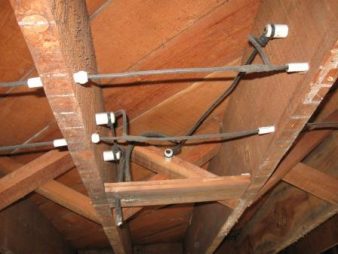What can you do to maintain your knob and tube wiring?
If you currently have K&T wiring in your home, here is some important maintenance advice to be aware of:
Bring in a qualified electrician to evaluate the system.
Don’t run too many applicances simultaneously, as this increases the risk of a fire.
Replace all you outlets with ground fault circuit interrupter (GFCI) outlets.
Replace any wiring that appears brittle or cracked.
Replace any K&T wiring servicing kitchens, bathrooms, laundry rooms, or outdoors. Wiring for these areas must be grounded.
Carefully remove any insulation surrounding K&T wires.
What is the life expectancy of knob and tube wiring?
Knob and tube can last a long time, theoretically. The functional part of K&T is copper wire, which can last upwards of 100 years. But, one of the main problems with K&T wiring is the insulation. The standard K&T insulation tends to become brittle and can easily break off, leaving bare wires exposed. Experts recommend reaplcing the wiring as soon as the insulation becomes brittle.
The replacement cost of a home’s entire system with copper wiring really varies depending on the size of the home and the amount of K&T wiring in place. But it is not outrageously expensive, and can be done fairly quickly, and with very minimal damage. The end result will be a more efficient, safer home, and will also increase the resale value should the time come when you decide to sell.
What will your home insurance company want to know?
Your insurance company will always want to know what type of wiring your home has. They’ll want to know if the entire house is on K&T wiring, or if some of the home has been updated. They may require you to have an electrician inspect the wiring before they can offer you home insurance. A number of problems can occur when only part of the house has been rewired, and the rest of the home still has K&T. The connections between the two systems may expand and contract at different rates, causing connections to loosen.
Also, K&T wiring runs on a 60-amp service, but most insurance companies will require your home to have 100-amp service.
There are companies that will refuse to insure a home with K&T wiring, as they consider the risk to be too high. However, there are others that will offer coverage with stipulations, perhaps with a higher premium or higher deductibles. There may also be a requirement to have an electrical inspection done by a professional before coverage can be offered.
Buying an older home has its benefits as well as its challenges. Having to cope with K&T wiring is definitely one of the biggest challenges you’ll face. However, if the wiring in your home is well-maintained and in good shape, even though it has been around for a while, you shouldn’t have a problem obtaining home insurance coverage.
Commonly asked questions
How can you tell if a house has knob and tube wiring?
If you’re not sure whether or not your house uses K&T wiring, take some time to do a brief inspection to find out. The easiest method is to visually check a few key areas, such as exposed joints in the basement or attic. Look for any white ceramic knobs nailed to the joists with electrical wiring twisting through them. Look for ceramic tubes wherever a wire passes through lumber. These are the main telltale signs that your house was wired using the K&T method.
You may still have K&T wiring in your home even if you don’t find any of these indicators. In these cases, plan a complete diagnostic to be absolutely certain of what wiring your home uses. In the end, you’ll feel safe, secure and more knowledgeable of your home overall — and both you and the property will be better off for it.
Can knob and tube wiring be grounded?
If the electrical outlets in your home have three prongs, it’s safe to say that the wiring connected to it has been appropriately grounded. Knob and tube wiring does not feature a third plug-in located just below the other two, and thus does not adequately protect from electrical shock if a wire comes loose.
If you’re trying to figure out what type of wiring your property has overall, however, simply checking your outlets for two or three plugs will not be enough. Since other electrical systems, such as sheathed duplex electrical wiring, also use two-pronged outlets, you’ll need to be more in-depth with your research before coming to a final determination.
Unfortunately, if you’re hoping to ground an existing K&T system you will be sorely disappointed. In the interest of staying up to code — not to mention ensuring your home is properly and safely wired top-to-bottom — you’ll have to rewire the whole property.
What is the cost of replacing knob and tube wiring?
The exact price of rewiring your house can change dramatically depending on size, overall conditions, age of the property, access to wiring, and other factors that are impossible to predict without a firsthand look. So, it’s best to consult with a licensed electrician to get an accurate estimation of what you can expect by project’s end.
Want to learn more? Visit our Getting to Know Your Home resource centre for the complete rundown on all your home's systems and features. Or, get an online quote in under 5 minutes and find out how affordable personalized home insurance can be.
About the expert: Arthur Kavanagh
Arthur has been a natural leader since the age of 18, having completed a 4-year electrician apprenticeship and overseen crews of up to 60 electricians. He is the founder of his own premiere electrical contracting company: Kato Electrical Inc.



